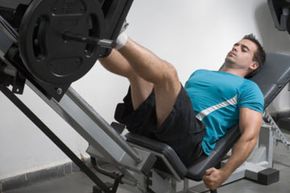Why doesn't just running farther or faster give you enough of a workout to build leg strength? Running builds endurance, but it's an inefficient way to increase muscular strength. What's needed are workouts that target specific muscle groups in your legs. Runners often fear that weight lifting and other workouts will slow them down, but this isn't something you have to be concerned about if you pursue a balanced exercise regime. Today, both professional and amateur runners use strength workouts to achieve a number of running goals.
Workouts can improve running skills, since well-developed muscles enable the body to use oxygen more efficiently and are slower to fatigue. This allows you to run faster on the flats and to power more easily up hills. Workouts also can help you to lengthen your stride, which allows you to run faster over distance. For sprinters, exercises that build strength aid a more explosive start and faster times. Developing leg muscles improves running form by reinforcing your alignment and helping you to maintain an upright posture. Stronger muscles also provide stability to joints, which means less wear and tear on ligaments and tendons.
Advertisement
Probably the most important reason for runners to build leg strength is to head off injuries. When muscles are weak, or when one group of muscles is less developed than others, the result is poor alignment. "Runners are notorious for their muscle imbalances, particularly through the hips," Maki Riddington, a strength and conditioning specialist, told the Houston Chronicle in 2008 [source: MacInnis]
For example, weak hip muscles can allow the legs to angle inward or outward instead of keeping each stride in line. Underdeveloped gluteal muscles might cause the runner to lean his or her trunk forward. An imbalance between opposing muscles, particularly, is a major cause of the repetitive stress injuries that plague runners [source: Everett]. Knees, hips and feet all suffer.
Strengthening your legs can be the most valuable time you spend during training. A running workout generally takes an hour or more, but you can perform a valuable strength workout in as few as 15 or 20 minutes. And the results soon will be apparent in your running and overall fitness level.
On the next page, you'll find out exactly which muscle groups you should be targeting in your workouts.
Advertisement
